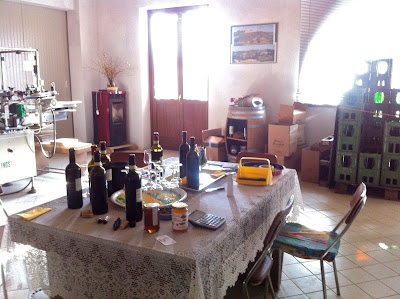The great wines of Piedmont are a popular counter-argument to the concept of natural wine. As much as wine geeks like myself might advocate use of wild yeasts, low sulfur, and total disavowal of pesticides, herbicides, anti-mildew agents and so on, we're still uniformly unable to refute the majesty of good Barolo and Barbaresco, appellations in which these virtuous habits are rare to non-existent. So visiting Piedmont recently I maintained a sort of hopeless mini-agenda to sniff out whatever natural or organic wines I could find in the area, out of curiosity for how Piemontese grapes would be affected by more or less natural viticulture.
What I tasted was, on the whole, immensely intriguing. Like, potential-business-opportunity intriguing, for someone with more means and patience and Italian skills than I presently possess.
There are apparently three small organic producers in Monforte alone. One, I'm told, is Francesco Clerico, a cousin of the more famous Domenico, neither of whose wines we were unable to taste on this trip. Another is Enrico Boggione, whose rich and vibrant Nebbiolo d'Alba is available for a song at the little organic boutique run by his wife off the main square in Monforte. The third is Giorgio Barovero, to whose stunning 2005 Nebbiolo d'Alba we were introduced by the excellent bartender at Casa della Saracca. My friend J and I enjoyed the wine so much we set up a tasting appointment for the next day, and drove the short distance to Barovero's spare cellars in the valley just south-east of Monforte, outside of the Barolo appellation, on the frontiers of Piemontese natural wine.
The Barovero estate began conversion to organic viticulture in 2002. 2003 was the first vintage Giorgio took over completely from his father, a grower who'd begun making a little wine to sell locally in the 70's. In 2004 the estate was certified organic, although Barovero tells us that due to 10mg. too much sulfur in the wine, the 2006 Nebbiolo d'Alba is not organic-certified.
Organic certification, of course, basically just means the avoidance of overuse of chemicals in the vineyard, and winemakers can then do whatever they like in the cellar. It is the intent that matters. Barovero took us out to see his Dolcetto vines behind his cellars, and they were indeed lively and overgrown, a whole different color to vines we'd seen elsewhere on the trip. He uses wild yeasts, minimal sulfur (usually), and as few chemicals as possible in the vineyards.
Unfortunately the 2006 Nebbiolo d'Alba, the wine I'd been most curious to taste, was indeed reduced on the nose and on the palate, and struck me as hard and unpleasant where Barovero's 2005 had been vivid and bright. The wine spends two years in a mixture of old barrique and large tonneaux, but I imagine Barovero is still experimenting with the recipe, as it were.
Giorgio also two Barberas and two Dolcettos, normale and superiore versions of both grapes. Dolcetto Superiore in particular is one of those near-contradiction-in-terms that one encounters only when tasting outside of the famous appellations with vignerons who must employ novel strategies to sell their wines. (Organic certification being no doubt one of them, albeit I would argue a very benign one.) Barovero in fact puts a great deal of stock in his old-vine Dolcetto, as evidenced by the fact that the Superiore we tasted was from 2006. (This is a grape that usually ages like an open bag of potato chips.) It was tremendously rich and Rhône-like, though it retained a familiar Dolcetto rasp and squawk.
It was impressive, but perhaps a hard sell, even at the low price, given that we don't usually turn to Dolcetto for steak-and-spuds wines. More familiar and much more drinkable was Barovero's basic 2010 Dolcetto, neon-bright and ebullient, an every-night-and-lunchtime sort of wine.
I less taken with the Barberas. For now the 2010 normale is one-note, and the 2006 Superiore is so concentrated it could pass for a Zinfandel.
I nevertheless left the tasting fairly abuzz with ideas, simply on the basis of the unpredictability of the wines we had met. I wouldn't have foreseen high-alcohol super-extraction in an organic Barbera any more than I would have a fresh-tasting Syrah-like organic Dolcetto from 2006. Not to mention the 2005 Nebbiolo d'Alba we'd first tasted, which remains my main source of optimism about natural wine in Piedmont. Chiefly because when writing an Italian wine list in the states, the hardest thing to find is an excellent glass-pour Nebbiolo. Either things are forbiddingly expensive, or they're limp or sad versions that fail to communicate the expressive potential of the grape. Barovero's 2005 and the bottle of Enrico Boggione Nebbiolo d'Alba we had later in the trip were both heartbreakingly cheap, and while they didn't taste like Barolo, they didn't take like second-tier versions of it, either. They were honest and refreshing country Nebbiolos, for which the market is, at present, utterly under-served.
Giorgio Barovero
Via San Sebastiano 27
12065 Monforte d'Alba
Italy
Tel: +39 017 378 310
Map
Related Links:
N.D.P. in Piemonte: Case della Saracca, Monforte d'Alba
N.D.P. in Piemonte: Walter Porasso at Bovio, La Morra
N.D.P. in Piemonte: Vinoteca Centro Storica, Serralunga
Related Links:
N.D.P. in Piemonte: Case della Saracca, Monforte d'Alba
N.D.P. in Piemonte: Walter Porasso at Bovio, La Morra
N.D.P. in Piemonte: Vinoteca Centro Storica, Serralunga
N.D.P. in Piemonte: Roberto Conterno, Monforte d'Alba
N.D.P. in Piemonte: La Cantinetta, Barolo
N.D.P. in Piemonte: Francesco Rinaldi e Figli, Barolo
N.D.P. in Piemonte: Capella di Sol Lewitt, La Morra
N.D.P. in Piemonte: Osteria La Salita, Monforte d'Alba
N.D.P. in Piemonte: Solativo Vinosteria, Ivrea
N.D.P. in Piemonte: Luigi Ferrando, Ivrea
N.D.P. in Piemonte: La Cantinetta, Barolo
N.D.P. in Piemonte: Francesco Rinaldi e Figli, Barolo
N.D.P. in Piemonte: Capella di Sol Lewitt, La Morra
N.D.P. in Piemonte: Osteria La Salita, Monforte d'Alba
N.D.P. in Piemonte: Solativo Vinosteria, Ivrea
N.D.P. in Piemonte: Luigi Ferrando, Ivrea










No comments:
Post a Comment